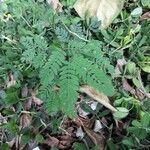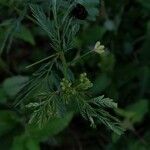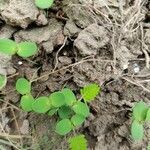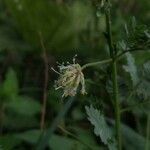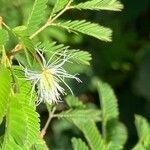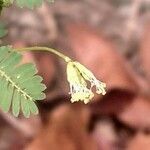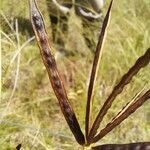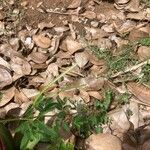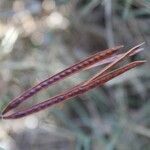Unarmed perennial herb or suffrutex up to 1 m high; young stems ± angular owing to the prominent decurrent striations from the base of each petiole, subglabrous to sparingly puberulous. Leaves sparingly to densely puberulous: petiole 0.2-1.8 cm long, usually with a large flattened discoid or ellipsoid gland immediately below the junction of the lowest pinna pair; rhachis 1-5.5 cm long; pinnae 3-5(7) opposite pairs, rhachillae 1-4 cm long; leaflets 9-20 pairs, 3-8 x 0.8-1.5 mm, linear to linear-oblong, acute apically, glabrous throughout or with marginal cilia. Stipules setaceous, up to 5 mm long, linear, persistent. Flowers white to pale yellowish-white, in heads up to 0.8 cm in diameter; peduncles up to 5 cm long. Calyx campanulate, tube up to 2.5 mm long, lobes up to 1.5 mm long, glabrous. Petals free, up to 4 mm long, glabrous. Stamens 10, filaments free, linear, 5.5-7 mm long; anthers eglandular apically. Ovary subsessile, glabrous; style slightly thickened above. Pods dark brown, 4-8 cm long, up to 4 mm wide, linear, straight or slightly curved, thinly subcoriaceous, compressed, dehiscing longitudinally. Seeds up to 3 x 2 mm, slightly compressed, sometimes somewhat angular, lying ± obliquely in the pod, dark brown; areole small, up to 1.5 x 1 mm.
Glabrous to subglabrous shrub or subshrub to 2 m tall. Leaves: stipules acicular, to 6 mm long; leaf axes with large, sessile, oval gland near base or at apex of petiole; pinnae to 9-jugate; leaflets 10-25-jugate, linear to lanceolate-linear, apiculate, with inequilateral base, c. 3.5-9 mm long, 2-4 mm wide, glabrous except for scattered, marginal, minute hairs. Flowers 6-10 in white heads on glabrous peduncles 9-75 mm long; calyx cupular, c. 2 mm long, shortly toothed; petals free, 3-4 mm long. Stamens 10. Pods linear, compressed, with several borne erect on each peduncle, 4-9 cm long, 2.5-4 mm wide, ±glossy, brown, 20-30-seeded. Seeds longitudinal to oblique in pod, quadrangular to oval, 2.5-3 mm long, 1.5-2 mm wide, brown.
Erect or ascending herb or subshrub up to c. 2 m high; stem woody at base, angular, glabrous or slightly puberulous. Stipules linear, subulate, 2.5-6 mm. Leaves: petiole 2.5-5 cm, with a gland at the junctions of the proximal pair of pinnae; pinnae 1-7 pairs; leaflets 10-25 pairs per pinna, linear-oblong, c. 4-9 by 1-2 mm, base oblique, apex obtuse or apiculate; both surfaces glabrous, margins ciliate. Glomerules consisting of up to 10 flowers. Calyx cup-shaped, c. 2 mm, indented to about half of its length. Petals oblong, c. 4 mm. Stamens 10. Pod reddish brown, linear, 5-9 by 0.3-0.4 cm, apiculate, glabrous, 20-30-seeded.
A shrub. It grows 2 m tall. It has long slender branches. The twigs are green and ribbed. The leaves are alternate and twice divided. There is a large gland at the base of the leaf stalk. The leaves have 2-5 pairs of pinnae and these have 12-18 pairs of leaflets. These are 3-4 mm long.
